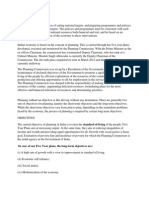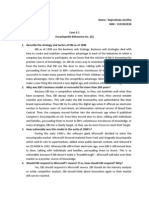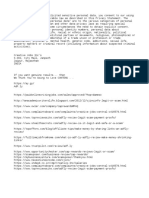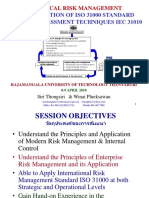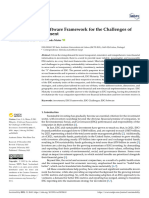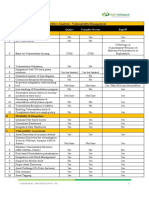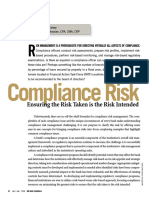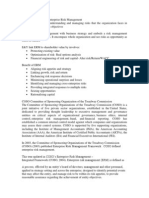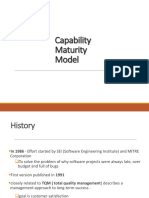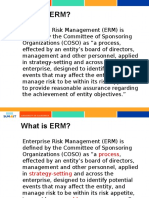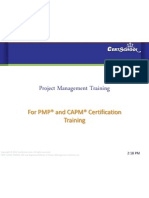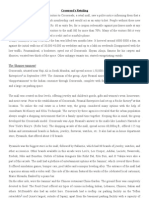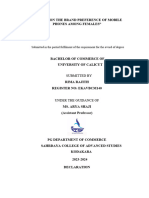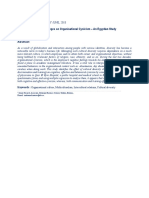Zimbra and ERM
Zimbra and ERM
Uploaded by
Stefan Pius DsouzaCopyright:
Available Formats
Zimbra and ERM
Zimbra and ERM
Uploaded by
Stefan Pius DsouzaCopyright
Available Formats
Share this document
Did you find this document useful?
Is this content inappropriate?
Copyright:
Available Formats
Zimbra and ERM
Zimbra and ERM
Uploaded by
Stefan Pius DsouzaCopyright:
Available Formats
1.
Describe The Steps In Zimbras Sales Process How Well Did Its Old Marketing
Automation System Support That Process What Problems Did It Create What Was The
Business Impact Of These Problems
Zimbra being an open source Software company uses viral marketing models, word-of-
mouth marketing and open standerds to its business. Zimbras sales model hinges on
driving large number of visitors to use trial software pack for free and then convincing
them to purchase full feature commercial version. Steps in Zimbras sales process.
a) Marketings responsibility is to deliver highly qualified leads for sales.
b) Marketing team drafts a series of automated emails that are sent to registered
prospects.
c) sales team personally calls qualified prospects
d) Zimbra uses its website to track visitor activity and tie it to the sales lead
The Zimbra team initially turned to two technologies to streamlining sales and marketing
and selected Salesforce.com for their CRM software and Eloqua for marketing
automation. The marketing team faced problems with delivering marketing automation
programs as flexibly and quickly as the market demanded.
Eloqua tended to be hard to use for both marketing and sales. Editing marketing programs
took days of tweaks and debugging leading to missed sales opportunities.
2. List And Describe Zimbra S Requirements For A New Market Software. If you are
preparing the RFP for Zimbras new system, what questions would you ask?
Zimbra needed a marketing software package which was highly effective and cost
efficient. Their new software had to be more streamlined than the old one from Eloqua. It
needed to focus on lead generation, e-mail marketing, and Web analytics. Providing a
comprehensive sales and marketing automation solution that is easy to use and quick to
update, fully integrating with the Salesforce.com customer relationship management
(CRM) system Also, it had to be easy to install and maintain. integrates email, contacts,
shared calendar, instant message, documents with sharing capabilities, advanced search
and VoIP into a browser-based interface. If I was preparing the RFP (request for
proposal) for the new system I would ask:
a) what exactly was needed in the software,
b) how many people would be available for managing of the system,
c) the price range allowed for the software.
3. How Did The New Marketing System Change The Way Zimbra Ran Its Business How
Successful Was It?
Zimbra redeployed its marketing automation processes on LoopFuses OneView on-
demand offering. The team deploy several lead nurturing campaigns based on specific
web-form registrations and user activity. Registrations are now sent to Salesforce.com
immediately and updated with an assigned sales representative. LoopFuse then emails the
prospect with a personalized email addressed specifically to the contact, and addressed
from the assigned salesperson. This correspondence is also recorded in Salesforce.com as
are any email opens and subsequent website visits and registrations. When a sales rep
receives a reply directly into their email inbox, they can see the complete contact history
and instantly know how long the prospect has been evaluating the software, and guage
their interest. quick response to alerts with a follow up phone call increases getting the
prospect on the phone at a time when they are thinking about their possible purchase.
sales and marketing efficiency went up 50% for reaching out to customers and closing
business. LoopFuses OneView reduced the amount of time Zimbra spent using and
mentaining its marketing system. Zimbra received a jump in close rate on qualified leads
from 10 to 15 % by using the new software.
Electronic Medical Records a Cure for Health
Care
1. What people organization and technology factors are responsible for the difficulties in
building electronic medical record systems? Explain your answer.
Building an electronic medical record (EMR) system comes with difficulties. These
difficulties include; people, organization and technology factors
Doctors
Extended hours of training it will take for them to successfully use an EMR system. Doctors
are already pressed for time and learning to successfully use an EMR system could take up to
20 hours of training.
Government
Different systems that can be integrated into a medical facility, but not all of these different
systems will be comparable with one another. This causes problems when it comes to nation
wide accessibility.
Insurance companies
Insurance companies also play a role in EMR systems. With an EMR system claims will be
able to be processed immediately. Another problem comes with people; some are worried
about the confidentiality of online medical records.
Financial
This barrier includes those related to the monetary issues involved in implementing EMRs.
Physicians face the most common questions, whether the costs of implementing and running
an EMR system are affordable and whether they can gain a financial benefit from it. High
Start-up costs include all the expenditure needed to get an EMR system working in the
physician's practice. High ongoing cost: implementing an EMR system requires extensive
commitment to system administration, control, maintenance, and support in order to keep it
working effectively and efficiently. These costs include the long-term expenditures incurred
in monitoring, modifying, upgrading and maintaining EMRs, which will be significant.
Technical
Electronic Medical Records are hi-tech systems and, as such, include complex hardware and
software. A certain level of computer skills by both suppliers and users (the physicians) is
required. Physicians have insufficient technical knowledge and skills to deal with EMRs, and
that this results in resistance. Lack of technical training and support, Complexity of the
system, Limitations of the system, Lack of customizability, Lack of Reliability,
I nterconnectivity/Standardization, Lack of computers/hardware.
Time
The introduction of EMRs will slow a physician's workflow, as it will always lead to
additional time being required to select, implement and learn how to use EMRs, and then to
enter data into the system. As a result, their productivity will be reduced and their workload
will be increased. This can cause financial problems, such as a loss of revenue. Time
required to select, purchase, and implement the system, Time to learn the system, Time
required to enter data, More time per patient, Time to convert patient records.
2. What stages of system building will be the most difficult when creating electronic medical
record system? Explain your answer.
Implementation Phase of ERM would be the most difficult:
a) Create team of people whose entire job is to implement the EMR. There should be a
project manager to coordinate the entire project and someone involved in the medical
office's clerical functions. Modify the workflow and facility to accommodate the
EMR.
b) Develop templates for the most commonly-used procedures. This will make it easier
once you are using the EMR.
c) The implementation of EMR takes many months. Technology changes makes it
difficult and cost effective. The small hospitals having individual systems raises many
problem while implementing.
d) Install a backup system. This is extremely important, as electronic data is easier to
destroy all at once than paper data is.
e) Entering old data. Many nation wide hospitals will have different software of record
format making the system inaccessible due to incompatibility of various system in the
nation.
f) The systems needs to be user friendly the maintenance is a difficult process. The data
mining process has to be properly looked upon so as to give minute attention to the
detail so as to treat effectively. National Integration and maintenance will be a major
problem.
3. What is the business and social impact of not digitizing medical records (to individual
physicians hospitals insurers patients)
Laptop and computers are very common in todays generation so it is easy to maintain a
digital record of your data in order to be comprehensive of your current health conditions.
Paper records are bulky and the searching takes a lot of time keeping the patient in waiting
for a long time. EMRs hold real time adjudication thus making the system faster and
efficient. ERM helps in alerting the patients by automatic signals so that the patient becomes
more proactive and takes the necessary steps rather than waiting and making the ailment even
worse.
4. What are the business and social benefits of Digitizing medical recordkeeping?
ERM has many benefits : Shrinking probability of needless treatments and tests.
Digitizing medical records can eliminate many mis-dosing and other inappropriate surgeries
and treatments. Electronic medical record improves medical service time by making them
faster and patients have less stress. Doctor can make prescriptions, make appointments and
referrals at the same time through the digital EMR. EMR may help patients to get access to
personal health records conveniently on workstation and even on the mobile Phones too.
Business Benefits Include
EMR can cut down the cost by reducing less paper work. Data can be very well protected
with the EMR. Up-to-date record maintenance is easier with the use of EMR.
Maintaining Patient data in Paper form always consume time but EMR can be accessible
from multiple locations and thus help in easy data retrieval and saves time too.
You might also like
- Radical ReportingDocument254 pagesRadical ReportinganonymNo ratings yet
- Effectiveness of Social Media AdvertisingDocument75 pagesEffectiveness of Social Media AdvertisingAngelRamosManahan85% (26)
- Cobit Casestudy TIBODocument22 pagesCobit Casestudy TIBOAbhishek KumarNo ratings yet
- ERM CharterDocument3 pagesERM ChartertitooluwaNo ratings yet
- Mba Cumbria DetailsDocument44 pagesMba Cumbria DetailsDan Dan ChanNo ratings yet
- PruTech Corporate Deck-General PDFDocument13 pagesPruTech Corporate Deck-General PDFPotluri Phani Ratna KumarNo ratings yet
- Supply Chain Risk Management A Complete Guide - 2021 EditionFrom EverandSupply Chain Risk Management A Complete Guide - 2021 EditionNo ratings yet
- Appraisal of Planning in IndiaDocument12 pagesAppraisal of Planning in IndiaStefan Pius DsouzaNo ratings yet
- Tugas MCS Case2-1 SD 3 NajmalindaZenithaDocument4 pagesTugas MCS Case2-1 SD 3 NajmalindaZenithaNajmalinda ZenithaNo ratings yet
- ARCHIES The Way Indians GreetDocument14 pagesARCHIES The Way Indians Greetvicky9699No ratings yet
- RM Case 2Document2 pagesRM Case 2Jaswinder SinghNo ratings yet
- Scam ListDocument31 pagesScam ListSudeep Gupta25% (4)
- Project Proposal: Product Name: ERM (Electronic Medical Record)Document4 pagesProject Proposal: Product Name: ERM (Electronic Medical Record)Habib SheikhNo ratings yet
- Flowchart - How Can I Use The FSC TrademarksDocument1 pageFlowchart - How Can I Use The FSC Trademarksfcjr79No ratings yet
- ERM - RMUTT Presentation 8-9 April 10Document175 pagesERM - RMUTT Presentation 8-9 April 10Atif Ahmad KhanNo ratings yet
- Tcs FinalDocument26 pagesTcs Finalmeghapatel79No ratings yet
- Erm GuidelinesDocument109 pagesErm GuidelinesasifsubhanNo ratings yet
- A Governance Framework National Cybersecurity StrategiesDocument13 pagesA Governance Framework National Cybersecurity StrategiesDidane13No ratings yet
- PMP 2012 PrintDocument190 pagesPMP 2012 Printapi-101303155No ratings yet
- The Effect of Mandatory XBRL ADocument28 pagesThe Effect of Mandatory XBRL AWildany IlhamNo ratings yet
- KPMG Front Page PostDocument3 pagesKPMG Front Page Postjda_23No ratings yet
- 350 Third-Party Cyber Risk Management PrimerDocument5 pages350 Third-Party Cyber Risk Management PrimerrahulNo ratings yet
- Benefit Realization Management - Research PaperDocument43 pagesBenefit Realization Management - Research PaperKabir Ahmad100% (1)
- Creating The Smart Cities of The FutureDocument16 pagesCreating The Smart Cities of The FutureJamila AkermiNo ratings yet
- ESG Maturity A Software Framework For The ChallengDocument18 pagesESG Maturity A Software Framework For The Challengsujaysarkar85No ratings yet
- Cobit 1Document25 pagesCobit 1pj8714No ratings yet
- QB Brics and The NDBDocument18 pagesQB Brics and The NDBPauloestNo ratings yet
- A COBIT 5 OverviewDocument19 pagesA COBIT 5 OverviewAneuxAgamNo ratings yet
- Rapid 7 Competitive AnalysisDocument2 pagesRapid 7 Competitive AnalysisBharti SangwanNo ratings yet
- Compliance RiskDocument6 pagesCompliance RiskAndraNo ratings yet
- PEFC Why Labels MatterDocument8 pagesPEFC Why Labels MatterPEFC UK Ltd.No ratings yet
- Risk Management ProposalDocument13 pagesRisk Management ProposalromanNo ratings yet
- Name Net IQ Group Number: Website Link: Tutorial Details Time Spent On AssignmentDocument11 pagesName Net IQ Group Number: Website Link: Tutorial Details Time Spent On AssignmentJohnLuceNo ratings yet
- Code of Best Practice On Corporate Governance Sri LankaDocument36 pagesCode of Best Practice On Corporate Governance Sri LankaSuranga FernandoNo ratings yet
- BBDM 3294 SBL L1 Governance (Agency & Stakeholders)Document62 pagesBBDM 3294 SBL L1 Governance (Agency & Stakeholders)Chong Soon KaiNo ratings yet
- RM VS ErmDocument2 pagesRM VS ErmHew Jhet NungNo ratings yet
- Effective Governance During SOA Lifecycle - Theory and PracticeDocument15 pagesEffective Governance During SOA Lifecycle - Theory and PracticepreethiscribdNo ratings yet
- Risk Management in E-BusinessDocument5 pagesRisk Management in E-BusinessTharindu ChathurangaNo ratings yet
- Val IT OverviewDocument12 pagesVal IT Overviewmax100No ratings yet
- Risk Management Framework For MCX (Stock Exchange)Document4 pagesRisk Management Framework For MCX (Stock Exchange)Anuj GoyalNo ratings yet
- XBRL and AccaDocument76 pagesXBRL and AccaValentin BurcaNo ratings yet
- Enterprise IT COBIT 5: Daftar PustakaDocument2 pagesEnterprise IT COBIT 5: Daftar PustakaMELISSA INDAH FIANTY (063252)No ratings yet
- Capability Maturity ModelDocument24 pagesCapability Maturity ModelRakhdiya22No ratings yet
- UltimateCertificationSuccess - PMBOK Guide Summary 1-5Document43 pagesUltimateCertificationSuccess - PMBOK Guide Summary 1-5Rana Ahmad AamirNo ratings yet
- CMMI Maturity LevelsDocument5 pagesCMMI Maturity LevelsJohn Matthew LabticNo ratings yet
- Risk ManagementDocument18 pagesRisk ManagementchirayutrivediNo ratings yet
- ISO 31000 Course PowerPoint v4Document175 pagesISO 31000 Course PowerPoint v4konsultan & trainingNo ratings yet
- Lecture 1-Introduction To CREM PDFDocument23 pagesLecture 1-Introduction To CREM PDFFadzir AmirNo ratings yet
- Opinions Practice Guide-IIADocument25 pagesOpinions Practice Guide-IIAMary Joy Dela Cruz - AgcaoiliNo ratings yet
- Proposed Roadmap Model For Developing A Corporate Risk Awareness Culture (Case Study at PT. PNM)Document6 pagesProposed Roadmap Model For Developing A Corporate Risk Awareness Culture (Case Study at PT. PNM)International Journal of Innovative Science and Research TechnologyNo ratings yet
- Project Management Conference PMP Overview: PMP Exam Ice Cracker! Dr. KanabarDocument57 pagesProject Management Conference PMP Overview: PMP Exam Ice Cracker! Dr. KanabarWaqas AhmedNo ratings yet
- Erm 101Document30 pagesErm 101aashulhedaNo ratings yet
- Vulnerability Validation TutorialDocument16 pagesVulnerability Validation TutorialCamilo Andres PachecoNo ratings yet
- (Laura F. Spira) The Audit Committee Performing C (BookFi)Document198 pages(Laura F. Spira) The Audit Committee Performing C (BookFi)THANDO DUBENo ratings yet
- Project EvaluationDocument36 pagesProject EvaluationMazhar AbbasNo ratings yet
- Lu en Isae3402-Ssae16 04072014 PDFDocument12 pagesLu en Isae3402-Ssae16 04072014 PDFChristen Castillo100% (1)
- Ghana Case StudyDocument26 pagesGhana Case StudyNii Lante AddisonNo ratings yet
- Topic 4 - Audit of Internal ControlsDocument91 pagesTopic 4 - Audit of Internal ControlsIanNo ratings yet
- Cococola PDFDocument109 pagesCococola PDFKumutha DavamoneyNo ratings yet
- Operational InnovationDocument2 pagesOperational InnovationAmrit PanditNo ratings yet
- Advantages and Disadvantages of Business Continuity Management (K. Venclova 2013)Document5 pagesAdvantages and Disadvantages of Business Continuity Management (K. Venclova 2013)ducuhNo ratings yet
- 2010 PMP Slides MarDocument379 pages2010 PMP Slides Marapi-101303155No ratings yet
- Ittihad University: Assignment TwoDocument12 pagesIttihad University: Assignment TwoZubaidah0% (1)
- Biometrics in Banking Security A Case StudyDocument17 pagesBiometrics in Banking Security A Case StudyAnonymous tZJktxmHSNo ratings yet
- Opportunities and Challenges of Doing Business in ChinaDocument5 pagesOpportunities and Challenges of Doing Business in ChinaSofia CastelliNo ratings yet
- 23 2015 Circular 2 - Time ExtensionDocument15 pages23 2015 Circular 2 - Time ExtensionStefan Pius DsouzaNo ratings yet
- To Whomsoever It May ConcernDocument1 pageTo Whomsoever It May ConcernStefan Pius DsouzaNo ratings yet
- Quick and Dirty Regression TutorialDocument6 pagesQuick and Dirty Regression TutorialStefan Pius DsouzaNo ratings yet
- Example of Web DeveloperDocument2 pagesExample of Web DeveloperStefan Pius DsouzaNo ratings yet
- Tata MotorsDocument2 pagesTata Motorsmanoj_No ratings yet
- Bharti AxaDocument1 pageBharti AxaStefan Pius DsouzaNo ratings yet
- The Case For Municipal MarketingDocument10 pagesThe Case For Municipal MarketingJoanna ChanNo ratings yet
- Case Study - CrossroadDocument3 pagesCase Study - CrossroadNaveed Ilyas100% (1)
- "A Study On The Brand Preference of Mobile Phones Among FemaDocument14 pages"A Study On The Brand Preference of Mobile Phones Among Femarimariba12No ratings yet
- Manu BiodataDocument4 pagesManu Biodatasupriya nayakNo ratings yet
- Course Planning SEMESTER JAN 2022/2022 (JJ221)Document5 pagesCourse Planning SEMESTER JAN 2022/2022 (JJ221)Cid AreNo ratings yet
- Directions of Marketing Research-Vitbs Project Report by MBA Students VinithaDocument29 pagesDirections of Marketing Research-Vitbs Project Report by MBA Students VinitharnsubudhiNo ratings yet
- Marketing PlanDocument19 pagesMarketing PlanDiane Elizabeth MuldongNo ratings yet
- Chapter 15Document15 pagesChapter 15Velia MonicaNo ratings yet
- Business Model Canvas: A Complete Guide - CleverismDocument11 pagesBusiness Model Canvas: A Complete Guide - CleverismdrfleetNo ratings yet
- Diane Donovan ResumeDocument1 pageDiane Donovan Resumeapi-12323032No ratings yet
- Analyzing Business Markets: Kotler KellerDocument22 pagesAnalyzing Business Markets: Kotler KellerRahmatullah Rassouli100% (1)
- Rural Marketing SagarDocument74 pagesRural Marketing SagarShital PatilNo ratings yet
- The Benefits of EDIDocument12 pagesThe Benefits of EDIGXSNo ratings yet
- Cross-Cultural Influences in Consumer BehaviourDocument11 pagesCross-Cultural Influences in Consumer BehaviourkundanooNo ratings yet
- Impact of Diversity Challenges On Organisational Cynicism - An Egyptian StudyDocument7 pagesImpact of Diversity Challenges On Organisational Cynicism - An Egyptian Studyleepsaiit@gmailcomNo ratings yet
- Business PlanDocument3 pagesBusiness PlanEricka Mae TayamoraNo ratings yet
- Writing An Effective Business PlanDocument4 pagesWriting An Effective Business PlanAndra LaszloNo ratings yet
- Consumer Attitude Formation ChangeDocument73 pagesConsumer Attitude Formation ChangeABHISHEK CHAKRABORTY100% (6)
- Thesis About TV AdvertisingDocument4 pagesThesis About TV AdvertisingDoMyCollegePaperUK100% (2)
- MIMS ProspectusDocument24 pagesMIMS ProspectusMackendro ChabungbamNo ratings yet
- What Is Marketing ManagementDocument6 pagesWhat Is Marketing ManagementAhmed NafeezNo ratings yet
- Market Potential by Ajay BansalDocument12 pagesMarket Potential by Ajay BansalajayNo ratings yet
- Notebook Bs ProjectDocument28 pagesNotebook Bs Projectjemsvasani15No ratings yet
- Soal Bahasa Inggris Kelas Xii GanjilDocument21 pagesSoal Bahasa Inggris Kelas Xii Ganjilyuhanita NurNo ratings yet
- Reference Groups & WOMDocument23 pagesReference Groups & WOMAnurag Malviya Student, Jaipuria Lucknow100% (1)








